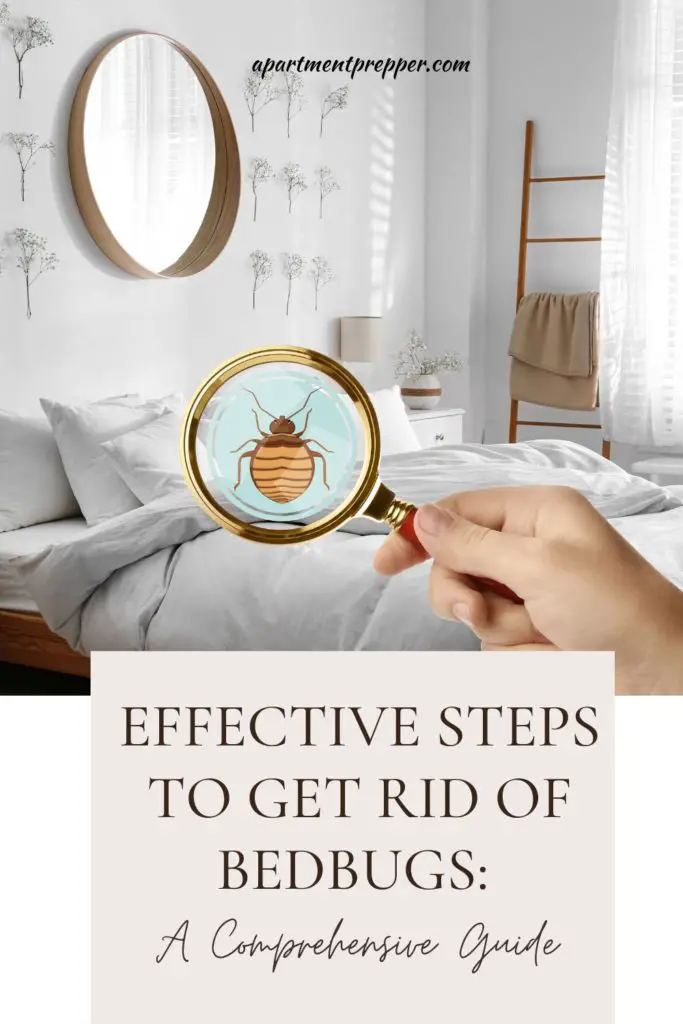Written by Bernie Carr
If you live in an apartment, there is a possibility you may get infested with bedbugs through no fault of your own. Apartment units in a big apartment complex can become infested, as bed bugs can travel through the walls. They come in through electrical outlets, cracks in the walls and even baseboards. Bedbugs can be a real nuisance. These tiny insects are notorious for their ability to hide in cracks and crevices, making them challenging to eradicate. If you’re dealing with a bedbug infestation, fear not! In this comprehensive guide, we’ll discuss steps to bid farewell to bedbugs and regain control of your home.
How do You Get Bedbugs in a Home?
Bedbugs are known hitchhikers, and they can find their way into homes through various means. Understanding how bedbugs can enter your home can help you take preventive measures. Here are some common ways a home can get bedbugs:
- Travel: Bedbugs often infest hotels, motels, and vacation rentals. If you stay in an infested room, bedbugs can hitch a ride in your luggage, clothing, or personal belongings and travel home with you.
- Used Furniture or Mattresses: Watch out for used furniture. Although many used pieces are likely clean, bringing in second-hand furniture, especially mattresses and upholstered items, without thorough inspection can introduce bedbugs into your home. These pests can hide in the seams and crevices of these items. Inspect any furniture before bringing it in.
- Clothing and Personal Items: Bedbugs can hide in clothing, bags, or other personal items. If you visit a place with an infestation and place your items on infested surfaces, bedbugs can crawl into your belongings.
- Visitors and Guests: If guests or visitors to your home unknowingly carry bedbugs, they can transfer the pests to your living space. Bedbugs may move from one person’s belongings to another’s when bags or personal items are kept together.
- Public Transportation: Although less common, bedbugs can be found in public transportation, such as buses, trains, and taxis. If you come into contact with infested seating or luggage storage areas, you could unknowingly transport bedbugs home.
- Neighboring Infestations: Bedbugs are skilled at moving through wall voids and cracks in apartment buildings, condos, and townhouses. If your neighbor has an infestation, it’s possible for bedbugs to migrate into your home through shared walls or utility lines.
- Schools and Workplaces: In rare cases, bedbugs can be introduced into schools, workplaces, or other public places, and employees or students can bring them home on their clothing or belongings.
- Laundry Facilities: Bedbugs can also infest laundry facilities. If you use a public laundromat, there’s a chance you could pick up bedbugs from infested machines or nearby areas.
Don’t be too Hard on Yourself
Just because you somehow got bedbugs, it doesn’t mean that you’ve been dirty or careless. It’s important to note that bedbugs are not attracted to dirt or filth; they are attracted to warmth, carbon dioxide, and the scent of blood. Anyone can get bedbugs, and their presence is not necessarily an indication of poor hygiene.
To prevent a bedbug infestation, regularly inspect your living space, especially when you return from trips, and be cautious when bringing used furniture or clothing into your home. If you suspect or discover bedbugs, it’s essential to take prompt action to prevent the infestation from spreading. Consult a pest control professional for effective bedbug removal and prevention strategies.
Identify an Infestation
The first step in tackling a bedbug infestation is to confirm that these little critters are indeed the culprits behind your sleepless nights. What to look for: Look out for telltale signs such as reddish-brown bugs, tiny eggs, and dark spots (fecal matter) on your mattress, sheets, and surrounding areas.
How to Get Rid of Bedbugs
As soon as you notice an infestation, report it to your leasing office immediately. They are likely to send maintenance to eradicate the problem. However, if you don’t get any help right away, there are a few things you can do.
1. Declutter and Clean
Bedbugs thrive in cluttered environments, so begin the eradication process by decluttering your living space. Vacuum your floors, carpets, and upholstery thoroughly, paying special attention to seams and cracks where bedbugs might hide. Be sure to dispose of the vacuum bag immediately after use.
2. Launder and Heat-Treat Bedding
Strip your bedding, including sheets, pillowcases, and mattress covers. Wash them in hot water (at least 60°C or 140°F) and dry them on high heat for at least 30 minutes, and use your dryer at the highest heat setting (that your bedding can tolerate). Bedbugs cannot survive extreme temperatures, so this step helps eliminate them from your bedding.
3. Steam Cleaning
Invest in a steam cleaner to treat various surfaces such as mattresses, furniture, and baseboards. High-temperature steam effectively kills bedbugs and their eggs on contact, making it a valuable tool in your battle against these pests.
4. Encase Your Mattress and Box Spring
Encase your mattress and box spring in bedbug-proof covers. These covers create a barrier that prevents bedbugs from entering or escaping, effectively isolating them and making it easier to eliminate the infestation.
5. Natural Remedies
Several natural remedies and do-it-yourself treatments are touted as bedbug solutions. While some may have limited effectiveness, it’s important to note that they might not completely eradicate an infestation. Options include using diatomaceous earth, essential oils like citronella oil, lavender or tea tree oil, and homemade sprays.
6. DIY Treatments
You can also try commercial insecticides to get rid of bed bugs yourself. Look for EPA registered pesticides that mention they are effective against bedbugs in the label. Use a bedbug spray or powder that contains neonicotinoids or pyrethrins. The EPA has some advice if you’re thinking about room foggers to fight bed bugs.
Use foggers (bug bombs) only with extreme care and only if bed bugs are listed on the label. Improper use can harm your health or cause a fire or explosion. Foggers should not be your only method of bedbug control. The spray will not reach the cracks and crevices where bed bugs hide.
Environmental Protection Agency (EPA.gov)
7. Consult Professionals
If your efforts don’t yield satisfactory results, it’s time to call in the professionals. Pest control experts have the knowledge, experience, and specialized treatments to tackle even the most stubborn bedbug infestations. Always ensure you choose a reputable and licensed pest control service.
8. Prevent Future Infestations
Once you’ve successfully eliminated the bedbugs, take preventive measures to avoid a recurrence. Regularly vacuum your home, keep clutter to a minimum, and be cautious when purchasing second-hand furniture. Consider using bedbug-resistant mattress encasements and inspect any new or used items before bringing them into your home.
Natural Repellents
If you prefer to try natural repellents first, citronella essential oil is known to deter bedbugs.
You can try the following methods (make sure you keep them away from children and pets):
- Citronella Spray: Mix a few drops of citronella essential oil with water in a spray bottle. Shake well and spray it in areas where you suspect bedbugs may be hiding, such as cracks, crevices, and around the bed. However, remember that citronella primarily repels insects rather than kills them, so it may not be a foolproof solution.
- Citronella Candles or Diffusers: Burning citronella candles or using a citronella diffuser in your bedroom may help deter bedbugs, but again, this is more of a deterrent than a direct bedbug eradication method.
Citronella Plants: Growing citronella plants around your home may help keep certain pests, including mosquitoes, at bay. However, it’s unlikely to have a significant impact on bedbugs as they primarily hide in indoor spaces.
While citronella can be useful for repelling certain insects, it’s important to understand that bedbugs have different behaviors and habits compared to mosquitoes or outdoor pests. For bedbug infestations, if the natural methods don’t work, you’ll need to use other methods mentioned above like thorough cleaning, vacuuming, steam treatments, and possibly professional pest control services.
How do you Relieve Itchy Bed Bug Bites?
A few essential oils can be used to relieve itching from bed bug bites:
You can use commercially prepared anti-itch products such as Benadryl anti-itch gel. Some essential oils that may also help to soothe bed bug bites. Mix a 20 drops of essential oil (or a combination) with a cup of water. Place in a spray bottle and spray on the affected area. (Keep the spray away from eyes, kids and pets.)
- mint (including peppermint or spearmint) essential oil have some insect-repellent properties and provide a cooling sensation.
- You can also try lavender essential oil for calming properties.
- Rosemary oil can also relieve itching, as well as tea tree oil, which is anti-microbial.
Conclusion
Dealing with a bedbug infestation can be a frustrating experience, but with the right approach, you can successfully rid your home of these pests. By identifying the problem, cleaning and treating your living space, and taking preventive measures, you can ensure a bedbug-free environment and enjoy restful nights once again. If the infestation persists, don’t hesitate to seek professional help. With determination and persistence, you’ll be able to say goodbye to bedbugs for good.
About the author
Bernie Carr is the founder of Apartment Prepper. She has written several books including the best-selling Prepper’s Pocket Guide, Jake and Miller’s Big Adventure, The Penny-Pinching Prepper and How to Prepare for Most Emergencies on a $50 a Month Budget. Bernie’s latest e-book, FRUGAL DIY has just been released on Amazon. Her work appears in sites such as the Allstate Blog and Clark.com, as well as print magazines such as Backwoods Survival Guide and Prepper Survival Guide. She has been featured in national publications such as Fox Business and Popular Mechanics. Learn more about Bernie here.
FB: https://www.facebook.com/apartmentprepper
Instagram: https://www.instagram.com/apartmentpreppers/
Twitter: https://twitter.com/AptPrepper
YouTube: https://www.youtube.com/channel/UC7vOtdbo-wiBeBxD6puCr1Q
Patreon: https://patreon.com/apartmentprepper
Pinterest: https://www.pinterest.com/aptprepper/
Today’s societal climate not supportive of prepping. With your help, we can keep bringing you content that is often suppressed. Help keep Apartment Prepper alive.
Join me on Patreon for ad-free content.

Or Help out via Paypal



